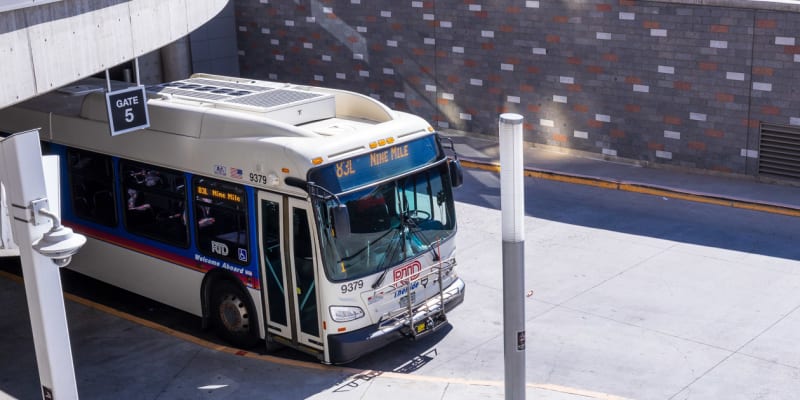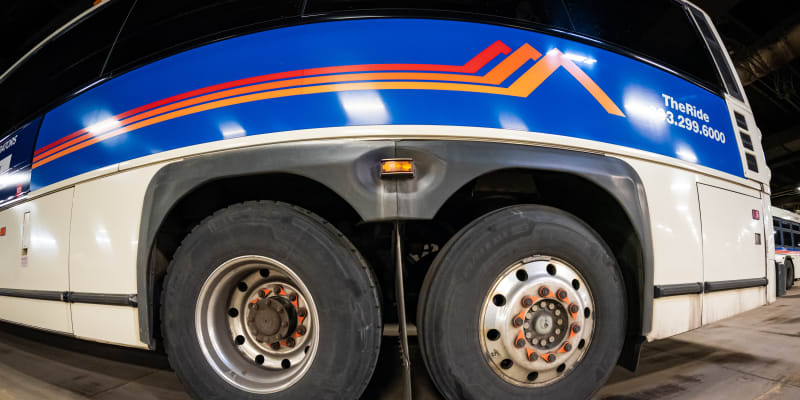
Accessible Bus Vehicles
All RTD buses, including the Free MallRide, Free MetroRide, and rail vehicles, are accessible for mobility aids such as wheelchairs, electric scooters, segways, walkers, and crutches. Bus and rail operators are trained to assist passengers with disabilities boarding or exiting the vehicle.
Page 1 of 1
 Access-a-RideAccess-a-Ride is RTD’s ADA complementary paratransit service. It is a shared-ride service intended for those who cannot use regular fixed-route bus/light rail service due to a disability.
Access-a-RideAccess-a-Ride is RTD’s ADA complementary paratransit service. It is a shared-ride service intended for those who cannot use regular fixed-route bus/light rail service due to a disability. Access-on-DemandAccess-on-Demand is an optional subsidized curb-to-curb service using taxi and ride share providers. Individuals with current certification for Access-a-Ride are eligible to use the service. Learn more about this service here.
Access-on-DemandAccess-on-Demand is an optional subsidized curb-to-curb service using taxi and ride share providers. Individuals with current certification for Access-a-Ride are eligible to use the service. Learn more about this service here. Free MallRide
Free MallRide
FAQs
How do I board and deboard the bus using a mobility aid?
The bus operator will clear the securement area and will attempt to board Individuals with a mobility aid prior to boarding others waiting at the bus stop to ensure access to the securement areas. If you use a wheelchair you may board the bus forward or backwards. If needed, ask the bus operator for assistance when boarding. Position your mobility aid in one of the designated securement areas so it does not block the aisle. Passengers using the lift or ramp may exit at any designated stop, unless the lift cannot be deployed or other conditions make the stop unsafe.
Will the bus operator secure my wheelchair for me?
Yes, but you have the option to be secured. It is not required that you secure your wheelchair. Bus operators are instructed to offer securement to all passengers using wheelchairs and have been trained to do so properly. Inform the operator if you have a particular way you would like your wheelchair secured.
Am I required to have my wheelchair secured?
No, but you must position your wheelchair in the securement area.
How many wheelchairs are allowed in the securement area?
All RTD buses have been designed to meet the Federal Regulations regarding Accessibility. Each securement area is designed to secure one (1) individual who uses a wheelchair.
What if the lift or ramp is inoperable?
Bus operators will attempt to contact RTD dispatch by all methods available. The Dispatcher will provide the operator with information on how you will be accommodated and the operator will relay the information to you. In either situation, if the next bus is not due to arrive for more than 30 minutes, the bus operator will offer you a transfer, and arrange alternative transportation before leaving the stop.
What is the difference between the securement area and the priority seating area?
All RTD buses have securement and priority seating areas that are designated, with signage, for persons with disabilities or passengers using mobility aids.
“Securement Area” or “Securement Areas” means one or both of the areas required on a fixed route bus for the purpose of securing a wheelchair.
“Priority Seating” means the first row of seating that is not the Securement Area or Securement Areas. At least one (1) set of forward-facing seats will be so designated as priority seating.
How do I go from an Access-a-Ride user to a fixed route user?
With more than 140 bus routes traveling from north to south, east to west, and all points in between, you can get where you're going fast and hassle-free on RTD fixed route services. Fixed route service is free of charge for all Access-a-Ride users and offers you more freedom and flexibility. Learning to ride RTD fixed route is easy and we can help with the transition.
RTD offers a Free Travel Training Program which is designed for seniors (60+), people with disabilities, and others living with mobility limitations to learn how to ride public transit as a way to expand their transportation options and save money. There is no charge for the Travel Training Program. Participants can ride the fixed route and FlexRide buses for free and their Access-a-Ride service will remain unchanged. To learn how to ride transit, please contact RTD Training at 303-299-4144 or [email protected].
Bus Wheelchair Securement and Priority Seating
Customers using a wheelchair must use the designated securement area and may secure or unsecure their wheelchair without assistance from the operator. Customers may also utilize operator assistance for securement--RTD provides “Secure Here” stickers and “Stoke Straps” for the customer to indicate how and where securement straps should be attached to the wheelchair. To obtain stoke straps, ask the operator or call 303-299-4056.
Policy for Bus Wheelchair Securement Area and Priority Seating
Individuals who use mobility aids, including wheelchairs, have equal access to the securement areas on buses.
Accessible Seating
Will the driver clear an accessible seat for me?
Yes, the bus operator will request other passengers move to make an accessible seat available for you.
What if the securement area is full?
If the securement area is full with other passengers using mobility aids the bus operator will contact their dispatcher using a high priority message for a quick response. They will fill out the ADA PAX PASS UP FORM, give you a copy, and relay to you how you will be accommodated.
What if a passenger refuses to move from the securement area?
If an individual in the securement area does not move at the bus operator’s request the operator will contact their dispatcher using a high priority message for a quick response. The dispatcher will provide information on how you will be accommodated.
What rules do people with strollers and large items need to follow?
Able bodied passengers traveling with large items, such as luggage, grocery caddies, and strollers must sit behind the bus Wheelchair Securement and Priority Seating areas and position their items so they are out of the aisle. They may use the extra space area for themselves and their belongings.
* Strollers must be collapsed prior to boarding. Only folded strollers will be allowed on board.
* All items must be readily movable and stowed behind the bus Wheelchair Securement and Priority Seating areas.
Disabled passengers using strollers will be allowed to board with their stroller un-collapsed and may sit in the securement area.
What is the responsibility of the driver when dealing with strollers, large items, and mobility devices?
The bus operator will ask all passengers boarding with large items, such as luggage, grocery caddies, and strollers to use the extra space area for themselves and belongings. If a passenger refuses to use the extra space area and creates a conflict, the bus operator will contact their dispatcher for further instruction.
What does RTD consider to be a mobility device?
A “mobility aid” means a device, such as a wheelchair, scooter, or walker, designed for and used by an individual with a disability for the purpose of mobility, not for convenience only.